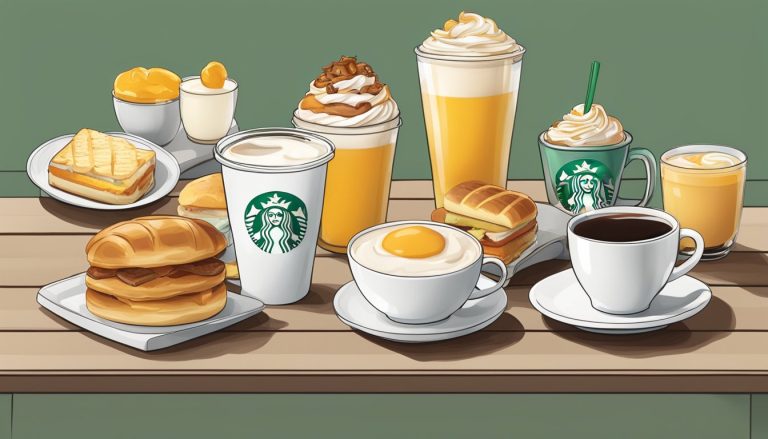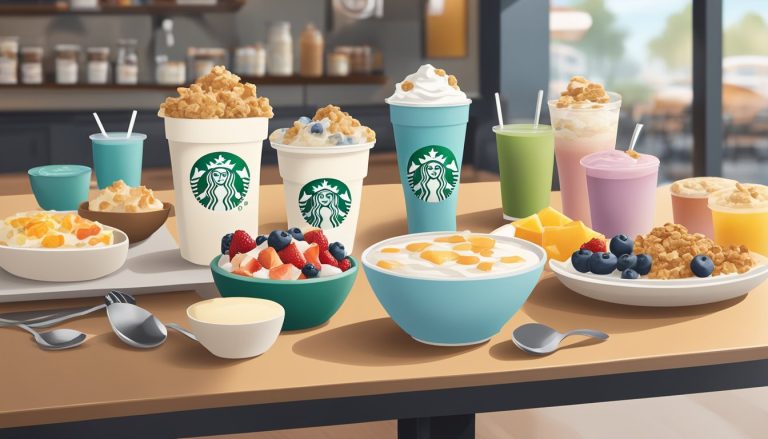Starbucks, the world’s largest coffeehouse chain, has mastered the art of breakfast marketing. As a premium coffee brand, Starbucks has expanded its offerings to capture a significant share of the morning meal market. The company’s breakfast marketing strategies have driven its food business to nearly $3 billion in North America, with a focus on all-day breakfast options.
Recognizing the importance of the breakfast daypart, Starbucks has implemented innovative tactics to attract and retain morning customers. These strategies include menu diversification, strategic partnerships, and leveraging digital platforms to enhance convenience. By creating a unique brand experience that extends beyond coffee, Starbucks has positioned itself as a go-to destination for breakfast seekers.
The success of Starbucks’ breakfast marketing efforts lies in its ability to adapt to changing consumer preferences while maintaining its core identity as a premium coffee brand. Through careful analysis of market trends and customer feedback, Starbucks continues to refine its breakfast offerings and promotional approaches, ensuring its position as a leader in the competitive morning food and beverage landscape.
Starbucks’ Brand Identity and Its Impact on Breakfast Offerings
Starbucks’ brand identity profoundly shapes its breakfast offerings, creating a unique experience that extends beyond coffee. The company’s emphasis on quality, community, and innovation influences its breakfast menu and marketing strategies.
Evolution of Starbucks’ Brand Experience
Starbucks has transformed from a coffee bean retailer to a global lifestyle brand. This evolution is reflected in its expanded breakfast menu, which now generates nearly $6 billion annually. The company’s commitment to quality ingredients and innovative flavors aligns with its premium brand image.
Starbucks regularly introduces new breakfast items that resonate with health-conscious consumers and food trends. These offerings include protein boxes, egg bites, and plant-based options. By diversifying its menu, Starbucks caters to changing customer preferences while maintaining its core identity.
The brand’s storytelling approach extends to its breakfast items. Each product often comes with a narrative about its origins or ingredients, reinforcing Starbucks’ commitment to transparency and quality.
The ‘Third Place’ Concept and Breakfast Marketing
Starbucks’ ‘Third Place’ concept – a comfortable space between home and work – significantly impacts its breakfast marketing. This philosophy creates an inviting atmosphere for morning customers, encouraging them to linger and enjoy their breakfast.
The company designs its stores to facilitate morning routines. Comfortable seating, free Wi-Fi, and efficient service cater to customers who want to start their day at Starbucks. This environment supports the marketing of breakfast items as part of a complete morning experience.
Starbucks leverages its mobile app and rewards program to promote breakfast offerings. Personalized notifications and exclusive breakfast deals incentivize customers to choose Starbucks for their morning meal. This digital strategy aligns with the brand’s innovative image and enhances customer loyalty.
Integrated Marketing Strategy: The Starbucks Way

Starbucks employs a comprehensive approach to marketing its breakfast offerings, combining promotional tactics with strategic pricing. The company leverages various channels to boost morning sales while maintaining a premium brand image.
Promotional Tactics for Morning Sales Boost
Starbucks utilizes targeted promotions to drive breakfast traffic. The company offers limited-time seasonal beverages and food items to create excitement and urgency. Mobile app notifications alert customers to morning specials and new menu items.
In-store signage and digital displays showcase breakfast pairings and bundle deals. Starbucks also partners with delivery platforms to reach customers who prefer to eat at home or work.
Social media campaigns highlight breakfast options through appetizing visuals and influencer partnerships. The brand encourages user-generated content by featuring customer photos of morning Starbucks runs.
Price and Premium Pricing Strategy
Starbucks maintains its premium positioning through strategic pricing. The company sets prices slightly higher than competitors to reinforce its quality image. This approach allows Starbucks to command higher margins on its breakfast items.
However, Starbucks offers tiered pricing options to cater to different customer segments. Value-conscious customers can opt for simpler breakfast choices, while premium options satisfy those willing to splurge.
The Starbucks Rewards program provides discounts and free items to frequent customers, incentivizing repeat breakfast purchases. This loyalty system helps offset the premium pricing for regular patrons.
The Digital Edge: Mobile Engagement and Personalized Marketing

Starbucks leverages digital technology to enhance customer engagement and drive sales. The company’s mobile app and rewards program form the cornerstone of its digital marketing strategy.
Starbucks Mobile App and Mobile Ordering
The Starbucks mobile app, launched in 2009, revolutionized the coffee-buying experience. It allows customers to order and pay for drinks in advance, reducing wait times and improving convenience. By 2019, mobile orders accounted for 31% of Starbucks’ total orders.
Key features of the app include:
- Mobile order and pay
- Store locator
- Digital gift cards
- Customizable drink options
The app’s success stems from its user-friendly interface and seamless integration with Starbucks’ in-store operations. It provides real-time updates on order status and estimated pickup times.
Personalization Through Starbucks Rewards Program
The Starbucks Rewards program, integrated with the mobile app, boasts over 28.7 million active members as of 2022. This loyalty program offers personalized marketing opportunities and incentivizes frequent purchases.
Program benefits include:
- Points (stars) for purchases
- Free drinks and food items
- Birthday rewards
- Exclusive offers
Starbucks uses data from the rewards program to tailor promotions and product recommendations to individual preferences. This personalized approach increases customer engagement and drives repeat visits.
The program’s success is evident in its 16% year-over-year growth. It has become a key driver of Starbucks’ digital marketing strategy, fostering brand loyalty and increasing customer lifetime value.
Sustainable Practices and Ethical Sourcing in Marketing
Starbucks integrates sustainability and ethical sourcing into its marketing strategy, showcasing a commitment to responsible business practices. This approach resonates with environmentally conscious consumers and enhances brand reputation.
Environmental Sustainability Initiatives
Starbucks implements various eco-friendly practices in its operations. The company has set ambitious goals to reduce waste and carbon emissions. In stores, Starbucks uses recyclable cups and encourages customers to bring reusable containers.
The coffee giant has also invested in renewable energy sources for its stores and roasting facilities. By 2025, Starbucks aims to cut its carbon footprint by 50% and reduce waste sent to landfills by 50%.
These initiatives are prominently featured in marketing campaigns, highlighting Starbucks’ dedication to environmental stewardship.
Ethical Sourcing and Community Involvement
Starbucks’ C.A.F.E. (Coffee and Farmer Equity) Practices program is central to its ethical sourcing efforts. This open-sourced initiative includes over 200 indicators covering financial transparency, worker rights, and environmental conservation.
The company sources ethically produced coffee, supporting fair wages and sustainable farming practices. Starbucks also invests in coffee-growing communities through education and economic development programs.
These efforts are integrated into marketing messages, emphasizing Starbucks’ commitment to social responsibility. By showcasing these initiatives, Starbucks builds trust with consumers who value ethical business practices.
Enhancing the In-Store and Product Experience

Starbucks continually refines its physical spaces and menu offerings to create a compelling breakfast experience. The company focuses on innovative store designs, efficient drive-thru services, and creative food and beverage options to attract and retain morning customers.
Innovative Store Design and Starbucks Drive-Thru
Starbucks redesigns its stores to optimize the breakfast rush. The company introduces dedicated pickup areas for mobile orders, reducing wait times during peak hours. Digital menu boards display customized offerings based on time of day and local preferences.
Drive-thru locations feature dual lanes to handle increased morning traffic. Advanced AI systems predict order volumes, helping staff prepare items more efficiently. Some stores test automated beverage machines to speed up service.
Comfortable seating areas with ample power outlets cater to customers who prefer to enjoy their breakfast in-store. Free WiFi and ambient music create a welcoming atmosphere for those starting their day at Starbucks.
Product Innovation: Breakfast Items and Beverages
Starbucks regularly updates its breakfast menu to keep customers engaged. The company introduces seasonal items like Pumpkin Spice Lattes and holiday-themed breakfast sandwiches to generate excitement.
Healthier options such as egg white wraps and oatmeal bowls appeal to health-conscious consumers. Plant-based alternatives, including non-dairy milk options and meatless breakfast sandwiches, cater to growing dietary trends.
Starbucks collaborates with local bakeries to offer region-specific pastries and breakfast items. This strategy helps the company maintain a connection to local communities while providing unique options.
The beverage menu expands beyond traditional coffee drinks. Cold brew varieties and refreshing tea-based beverages offer alternatives for non-coffee drinkers. Customization options allow customers to personalize their drinks, creating a sense of ownership over their morning routine.
Loyalty Programs and Customer Relationship Management
Starbucks’ loyalty program and customer relationship management strategies form the cornerstone of its breakfast marketing efforts. These initiatives foster brand loyalty and create a strong emotional connection with customers.
Building Customer Loyalty Through Starbucks Rewards
Starbucks Rewards is a powerful tool for driving customer engagement and repeat business. Members earn stars on purchases, which can be redeemed for free food and drinks. The program offers tiered benefits, encouraging increased spending and frequency of visits.
Key features include:
- Mobile ordering and payment
- Personalized offers based on purchase history
- Free birthday rewards
- Exclusive access to limited-time promotions
The rewards program integrates seamlessly with Starbucks’ mobile app, enhancing convenience for customers. This digital integration allows for targeted marketing of breakfast items and new menu offerings.
Cultivating Community and an Emotional Connection
Starbucks strives to create a sense of community and foster emotional connections with its customers. This approach extends to its breakfast marketing strategies.
Initiatives include:
- In-store events and workshops
- Social media engagement and user-generated content campaigns
- Partnerships with local organizations
- Sustainability and ethical sourcing programs
These efforts help position Starbucks as more than just a coffee shop, but a “third place” between home and work. By emphasizing shared values and experiences, Starbucks builds brand loyalty that transcends individual products.
The company’s commitment to social responsibility resonates with many customers, strengthening their emotional connection to the brand. This connection often translates to increased breakfast sales and overall customer retention.
Strategic Partnerships and Global Expansion

Starbucks has leveraged strategic partnerships and tailored expansion strategies to fuel its international growth. These approaches have enabled the coffee giant to penetrate new markets while adapting to local preferences and regulations.
Crafting Partnerships for Market Reach
Starbucks forms alliances with local companies to gain market insights and navigate regulatory landscapes. In India, the company partnered with Tata Consumer Products to establish a strong foothold. This joint venture allowed Starbucks to tap into Tata’s extensive distribution network and local expertise.
Similar partnerships exist in other regions. In China, Starbucks collaborates with Alibaba Group for digital ordering and delivery services. These alliances help Starbucks overcome entry barriers and accelerate growth in new territories.
Expansion Strategies and Localization
Starbucks adapts its offerings to suit local tastes and customs in different markets. In Japan, the company introduced unique flavors like sakura blossom frappuccinos. In the Middle East, Starbucks offers date-flavored beverages during Ramadan.
Store designs also reflect local culture and architecture. In Kyoto, Japan, Starbucks opened a location in a 100-year-old traditional townhouse. This approach helps the brand resonate with local customers while maintaining its core identity.
Starbucks also adjusts its expansion pace based on market conditions. In some regions, it opts for rapid growth through franchising, while in others it maintains tighter control through company-owned stores.
Niche Marketing: Targeting Diverse Audiences
Starbucks excels at tailoring its offerings to specific customer segments. The company’s niche marketing approach allows it to appeal to various demographics while maintaining brand consistency.
Appealing to Health-Conscious Consumers
Starbucks has expanded its menu to cater to health-conscious individuals. The company now offers plant-based milk alternatives, such as almond, soy, and oat milk. These options appeal to lactose-intolerant customers and those following vegan diets.
Reduced-sugar beverages and sugar-free syrups provide choices for calorie-conscious patrons. Starbucks has also introduced protein boxes and healthier snack options to complement its drink selections.
The company’s commitment to transparency is evident in its nutrition information displays. Calorie counts are clearly visible on menu boards, helping customers make informed decisions.
Engaging High-Income Spenders and Technology Early Adopters
Starbucks targets affluent consumers through its premium Reserve brand. These high-end stores offer exclusive coffee blends and unique brewing methods, justifying higher price points.
The company’s mobile app caters to tech-savvy customers. It allows for easy ordering, payment, and rewards tracking. Features like Mobile Order & Pay appeal to busy professionals who value convenience.
Starbucks has integrated voice ordering through platforms like Amazon’s Alexa. This innovation attracts early adopters of smart home technology.
Limited-edition merchandise and collaborations with luxury brands create exclusivity. These products appeal to status-conscious consumers willing to pay premium prices for branded items.
Assessing Starbucks’ Marketing Impact
Starbucks’ innovative marketing strategies have significantly influenced the coffee industry and consumer behavior. The company’s approach has solidified its position as a global leader while shaping coffee consumption trends worldwide.
Market Share and Consumer Behavior
Starbucks has captured a substantial market share in the coffee industry. The brand’s loyalty program and mobile app have played crucial roles in retaining customers and driving repeat purchases. Starbucks’ emphasis on creating a “third place” between work and home has resonated with consumers, fostering a sense of community.
Consumer preferences have shifted towards premium coffee experiences, largely influenced by Starbucks’ marketing efforts. The company’s focus on customization and seasonal offerings has catered to diverse tastes and preferences. This strategy has not only increased customer satisfaction but also encouraged higher spending per visit.
Analyzing Competitors in the Coffee Industry
Starbucks’ success has prompted competitors to emulate aspects of its marketing strategy. Many coffee chains now offer loyalty programs and mobile ordering options. However, Starbucks maintains its edge through continuous innovation and brand strength.
The company’s global presence has set a high bar for competitors entering new markets. Starbucks’ localization efforts, adapting products and store designs to suit regional tastes, have proven challenging for rivals to match. This approach has reinforced Starbucks’ position as a market leader in numerous countries.
Competitors have struggled to replicate Starbucks’ brand reputation and emotional connection with customers. The company’s commitment to ethical sourcing and community engagement has further differentiated it from other players in the industry.




